Sustainable forest management can be defined as the management of permanent forests, based on clearly defined goals concerning the sustained production of desired goods and services without inflicting damage to their intrinsic value nor compromising their future productivity nor leading to undesirable effects on the social and physical environment.
Definition provided by the International Tropical Timber Organization, adopted in 1992 by the International Tropical Timber Council.
Sustainable management means managing and using forests and woodlands in a manner and intensity which:
- Allows them to maintain their biological diversity, productivity, capacity for regeneration, vitality, and capacity to satisfy, now and in the future, their relevant ecological, economic, and social functions on the local, national, and global level and
- does not harm other ecosystems.
Definition of the Helsinki Process (Resolution H1 of the Ministerial Conference on the Protection of Forests in Europe)
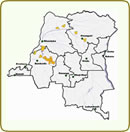
A pioneer in the field, SODEFOR began a vast program in 2005 for the management of its concessions in partnership with the French research bureau, FRMi. This partnership aimed to create management plans throughout the entirety of its network of concessions. It also, and especially, provided the starting point for true, sustainable forest management.
The company is also committed to the process of forest certification.
Developing the Management Plan
The development of the management plan is made up of three phases:
- The map database
- The management inventories
- Socio-economic studies
The map database
Preliminary, basic mapping, which is essential for any field activity: development of a georeferenced database based on pre-existing maps, GPS records, GIS (Sat Images and DEM). Continuous expansion of this database using information collected on the ground (forestry inventory, socio-economic studies).
Mapping the stratification of land use: road network, hydrographic network, anthropization (human settlements), forest stratification.
Cartographie de la stratification d’occupation du sol : réseau routier, réseau hydrographique, anthropisation (zones d’implantation humaine), stratification forestière.
GIS: drawn from a forestry map:

The management inventories
Evaluation of the wood resource available in the short, medium, and long term, assessment of wildlife and plant biodiversity, evaluation of non-lumber forest resources, survey of regeneration and phenology of the main commercial species, survey of key species.
There are multiple goals:
- Understanding and locating present and future production potential;
- Identifying and locating the presence of large mammals;
- Evaluating hunting pressure by local populations.
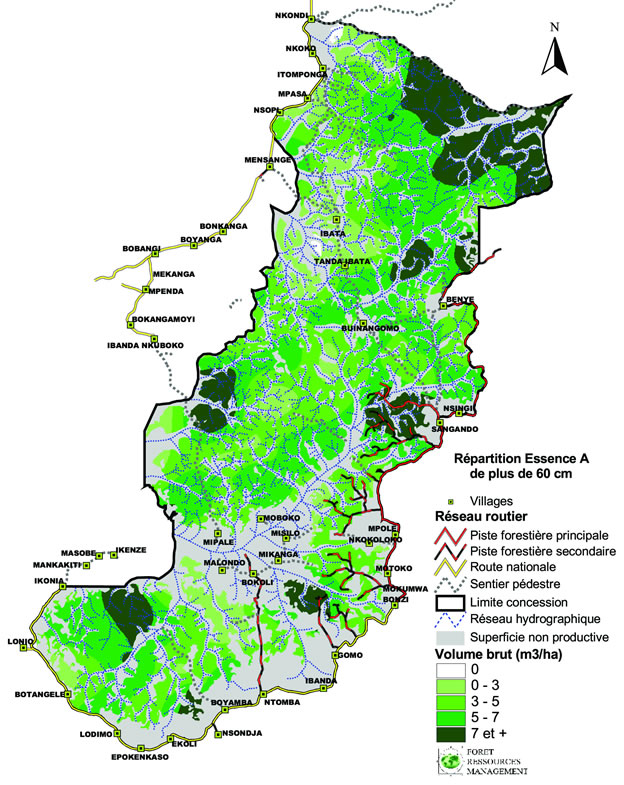

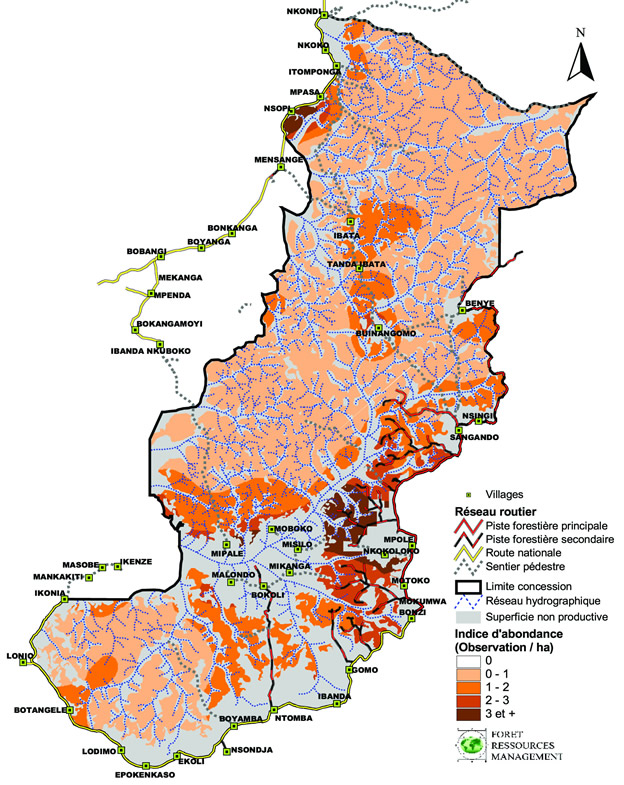
Socio-economic studies
Socio-economic diagnostics and outreach to local populations about management and logging activities.
- Outreach about the DRC’s forestry laws, presenting the management project being developed, and explaining the main stages of forest logging;
- Identifying the main axes of local development based on the description of demographic characteristics, the social environment (living conditions, household economics), local populations’ production systems, as well applicable laws and uses of the villages’ land.




- Analysis of living and working conditions of the local beneficiaries.
The goal is to define our contribution to the local development of the communities as well as to improve the living and working conditions of our agents.
Supporting Studies and Research
In Central Africa, forestry science knowledge is still very incomplete. In addition to the preparatory work in this Management Plan, SODEFOR has decided to invest in research programs in order to improve the management of the forests entrusted to it.
We partner with different research organizations to lead these programs: Royal Museum for Central Africa - Tervuren, the University of Kinshasa, The Université libre de Bruxelles, CIFOR, AgroParisTech ...



Permanent plots
These plots make it possible to monitor the dynamics of the concessions’ main ecosystems and to measure the impact of logging. 7 9-ha. blocks have been installed, another 10 to 15 will be installed over the next few years.
SODEFOR supports thesis research on the ecology, structure, and regeneration of the Wenge tree (Millettia laurentii) in the forests of the Nioki region.


Ring studies
A ring study is being carried out regarding the Wenge tree (Millettia laurentii) which aims to understand the growth speed of this species.

Promoting new tree species
The results of the management inventory show abundant resources of currently non-valued species of trees, which are poorly understood from a technological standpoint and by the forestry industry. Technological and machining trials will be carried out in partnership with research organizations.
Other
Other research themes may be developed during the implementation of the Management Plans. These could include, for example, research regarding particularly abundant species of large mammals, such as the bonobos in the Mpolé concession, or more advanced research about the plant diversity of forests classified as conservation areas. Partnerships with NGOs will be sought out.
Writing the Management Plan
The management plan is the culmination of all the studies carried out. But above all, it is the starting point for truly sustainable forest management. This management plan must be applicable and applied by everyone.
 One of the major stakes in forest management is successfully aligning production with forest resources. To do this, SODEFOR adapts its forest and industrial development, and its commercial prospecting, to the available resources, and manages its forest capital across both time and space in order to make the best use of it.
One of the major stakes in forest management is successfully aligning production with forest resources. To do this, SODEFOR adapts its forest and industrial development, and its commercial prospecting, to the available resources, and manages its forest capital across both time and space in order to make the best use of it.
Another major issue is being able to reconcile the company’s desire to continue to live off its primary trade, with the need to take into account all of the social and environmental constraints so that it can successfully be integrated within an exceptionally rich human and natural setting.
The Management Plan: a Land Distribution Document
The kind of forest management SODEFOR achieves is above all land management. People, forests, and animals live together on the area entrusted to us by the Democratic Republic of Congo. Our main concern is organizing this space in a way that affords all of them the means to continue living in harmony.
First of all, areas are cleared so that local populations can cultivate the land, based on the results of socio-economic surveys and initial dialogs with the villagers.
Our concessions include three distinct areas:
- Conservation areas that guarantee the protection of areas of particular ecological interest, such as rare ecosystems, or which are home to iconic animal species.
- Sensitive area protection zones: protective corridors for waterways (protection of riverbanks), steep slopes, wetlands, areas susceptible to erosion ...;

-
- Timber production areas, which correspond to industrial forestry production areas.
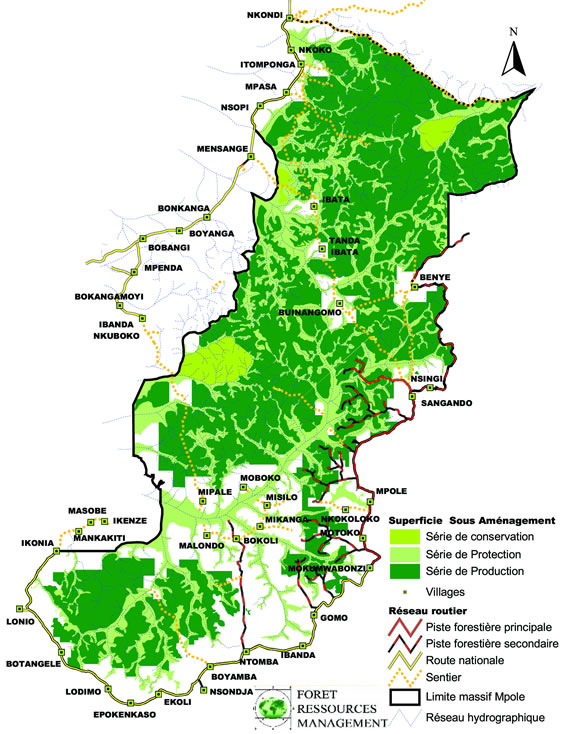
The Management Plan: a planning document for sustainable logging

Thanks to precise knowledge about the resources available in each concession, which we have acquired through preparatory studies leading up the management plan, our manager plans the timing and location of logging to ensure a sustainable production that preserves the balances of the forest ecosystem.
To do this, we created a model for the evolution of the current forests based on the inventory data and data on forest dynamics.
The Management Plan’s social measures
As part of the implementation of the management plan, and in order to have a forward-looking vision, we decided to launch a participatory initiative that accounts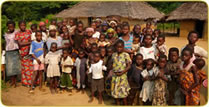 for the different components of the population: men, women, youth, and diverse ethnic groups. To do this, a permanent socio-economic team was installed in each concession. The team is composed of an agricultural engineer, a sociologist, and a pygmy. Its various missions are as follows
for the different components of the population: men, women, youth, and diverse ethnic groups. To do this, a permanent socio-economic team was installed in each concession. The team is composed of an agricultural engineer, a sociologist, and a pygmy. Its various missions are as follows
-
-
- Making contact with villagers;
- Acting as a link between the population and the company;
- Outreach about the forestry code and forestry laws;
- Carrying out social mapping with the population;
- Helping villagers organize themselves;
- Help villagers develop and negotiate their projects;
- Identifying development priorities with the population;
- Diminishing tensions and conflicts between the company and the population.
-
-
-
- Health
- Education
- Access to pure drinking water
-
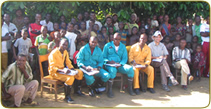

Biodiversity Management Measures
The management plan includes different measures aiming to protect local ecological diversity:
Identifying protection areas and conservation areas;
Establishing measures for reduced impact logging;
Planning studies for better understanding forest dynamics;
Setting management parameters (rotation time, forbidden species, and minimum logging diameters) to guarantee the reconstitution of the populations of managed species.
A fauna management system is implemented to combat the negative effects directly or indirectly caused by SODEFOR’s activities. Beyond this objective, SODEFOR encourages initiatives for supplying and developing fishing and husbandry as a means of reducing the consumption of bushmeat.
Already, the internal regulations adopted by SODEFOR aim to forbid any of its employees from participating in forbidden activities such as poaching or facilitating the illicit transport of bush meat, hunters, or hunting weapons. SODEFOR has implemented the necessary measures to supply sufficient protein, local or otherwise, for its employees without the use of any illegal activities.

SODEFOR is in no way liable for illicit actions committed by people outside of the company in the public sphere, and who have no connection to its logging and processing activities.
However, SODEFOR remains willing to join partnerships or programs aiming to preserve wildlife and to fight against poaching.
Reduced Impact Logging Measures
Improving logging technology is very important for optimizing timber as well for minimizing the impact on remaining tree populations and improving safety for loggers. Through an intensive training program, Sodefor ensures that its loggers accomplish their work in total safety, while minimizing impacts.
Implementing the Management Plan
One of the main challenges in forest management is implementing it. In fact, SODEFOR is being called upon to change from a “harvesting” forest logging company into an entity that is responsible for managing a natural space.
The 5-Year Management Scheme
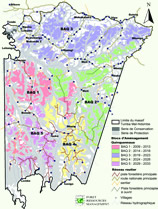
The management plan projects all of the company’s activities onto a Five-Year Management Block, which is a medium-term strategic policy. It defines the Annual Logging Stands, specifies how the road network will be planned, and sets out the social, environmental, and logging measures to be implemented as part of the Five-Year Management Block. Every five years there will also be an opportunity for a comprehensive review of the implementation of the Management Plan, and to update the concession’s sustainable management system.
The development of this Management Scheme is mainly based on the results of studies conducted on the entirety of the concession in preparation for the Management Plan. These studies are analyzed in more detail as part of the 5-Year Management Block.
Logging Inventory
The logging inventory covers the entire surface of the Annual Logging Stand, with an exhaustive count of available trees, which are marked on a map. It therefore serves to make available resources for a given year very clearly understandable.
This inventory is complemented with environmental survey information, such as the presence of sensitive areas (swamps, slopes, stream- and riverbanks). This information is crucial for allowing us to effectively conserve these areas.
Social Mapping
Constant dialog and collaboration with riverside populations, as well as the information they provide, are currently key elements in our management system. This collaboration, which began during the preparations for our Management Plan, will be deepened each year around the operational Annual Logging Stands.
Socio-economic surveys are carried out in preparation for the Annual Operating Plans by a specially designated team, in collaboration with surrounding villages. One or more village representatives are appointed by the villagers to participate in the development of a social map of the Annual Logging Stand, in partnership with SODEFOR’s Social Unit.
Precise mapping and marking the grounds of the particular sites located in the Annual Logging Stands (sacred sites, camps, ancient villages, sacred trees, main trees with competing resources, cemeteries and tombs...) will be carried out. The precise limits separating the concession from zones marked for rural development will be negotiated and marked out on the ground.
At the end of this task, specific management measures will be negotiated, which may extend to the full protection of certain areas or certain trees.
Annual Operations Plan
Annual planning is based on two major studies: the logging inventory and social mapping.
The Annual Operations Plan is a practical tool used by our site manager to carry out their operations in the forest. It contains, notably:
- The very precise results of the logging inventory, in terms of unit counts, standing volumes, and commercial volumes;
- maps of resource distribution, logging parcels, and the entire road infrastructure;
- social and environmental maps;
- specifications regarding management and logging rules to implement for the Annual Logging Stand.
Logging Traceability and Monitoring
As part of our concession's sustainable management certification, as well as to improve the effectiveness of our operations, implementing traceability over products along the entire production chain is indispensable for optimizing logging, ensuring logging measures are adhered to, and minimizing losses and abandonments. Good traceability therefore reduces the affected area per output volume unit and optimizes the use of the resources.
The logging inventory, which precisely maps available trees, provides the starting point for traceability. Then, at each step of production, the operations carried out (harvesting, skidding, cutting, and transport) are recorded. The information system we've developed allows us to:
ensure traceability, of logs and log sections, from the standing tree until export or processing;
detecting unjustifiable losses of log sections during the logging process (redollement studies)
evaluating yields and performances;
issuing all internal monitoring documents and documents intended for the forestry administration..
Post-logging diagnostics and evaluation of the implementation of the sustainable management system
A specific team in the forest ensures that the instructions of the management documents and work procedures have been adhered to: logging rules, sites that are protected due to their social or environmental performance.
Summaries of these diagnostics and reports evaluating the implementation of the management documents are prepared regularly.
